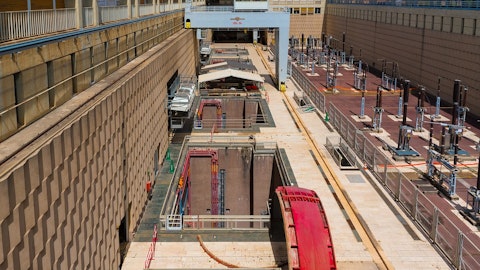Atkore Inc. (NYSE:ATKR) Q1 2024 Earnings Call Transcript February 1, 2024
Atkore Inc. beats earnings expectations. Reported EPS is $4.12, expectations were $3.62. Atkore Inc. isn’t one of the 30 most popular stocks among hedge funds at the end of the third quarter (see the details here).
Operator: Good morning. My name is Rob, and I will be your conference operator today. At this time, I would like to welcome everyone to Atkore’s First Quarter Fiscal Year 2024 Earnings Conference Call. [Operator Instructions] As a reminder, this conference is being recorded. Thank you. I would now like to turn the conference over to your host, John Deitzer, Vice President of Treasury and Investor Relations. Thank you. You may begin.
John Deitzer: Thank you, and good morning, everyone. I’m joined today by Bill Waltz, President and CEO; as well as David Johnson, Chief Financial Officer. We will take your questions after comments by Bill and David. I would like to remind everyone that during this call, we may make projections or forward-looking statements regarding future events or financial performance of the company. Such statements involve risks and uncertainties such that actual results may differ materially. Please refer to our SEC filings and today’s press release, which identify important factors that could cause actual results to differ materially from those contained in our projections or forward-looking statements. In addition, any reference in our discussion today to EBITDA means adjusted EBITDA.
And any reference to EPS or adjusted EPS means adjusted diluted earnings per share. Adjusted EBITDA and adjusted diluted earnings per share are non-GAAP measures. Reconciliations of non-GAAP measures in the presentation of the most comparable GAAP measures are available in the appendix to today’s presentation. With that, I’ll turn it over to Bill.
Bill Waltz: Thanks, John, and good morning, everyone. Starting on Slide 3, Atkore is off to a strong start for FY ’24, and we are demonstrating the structural improvements and transformation that we made to our business over the past several years. I’m proud to share that volumes for the quarter were up 13%, driven by contributions across all key product areas. We’re focused on executing our capital deployment model as evidenced by the $96 million in shares repurchased in the first quarter and the continued activity in January. In addition, I’m very pleased to announce that we’ve officially declared our first quarterly dividend, a very exciting achievement for our company. I also want to highlight the release of our fiscal year 2023 Sustainability Report, which was published last month.
This report provides an update on the progress against our 2025 targets and covers additional important topics and initiatives. I’d like to take a moment to thank all of our employees for everything they do to support our key stakeholders. Overall, in fiscal 2024, we’re off to a great start, and I continue to be excited for what’s to come. With that, I’ll now turn the call over to David to talk through the results from the first quarter and our outlook for the full year.
David Johnson: Thank you, Bill, and good morning, everyone. Moving to our consolidated results on Slide 4. In the first quarter, net sales were $798 million and adjusted EBITDA was $214 million. We are pleased with our margin performance in the quarter with adjusted EBITDA margins over 26%. Our tax rate in the quarter was favorable due to the vesting of previously granted stock compensation. This outsized benefit was unique and contributed to our strong EPS performance. Moving forward, we expect the rate to be closer to roughly 25% for the remaining quarters in the year. Turning to Slide 5 in our consolidated bridges. I’m pleased by our strong volume performance in the quarter with organic volumes up over 13%. These gains were offset by the continued pricing normalization, but this impact was within expectations and aligns with the pricing trends we have been discussing for the past several years.

Moving to Slide 6. We’re making good progress against the low double-digit volume expectation for the full year, with solid contributions across all key product areas. Our plastic pipe and conduit category was up high-single digits, led by solid growth in our PVC products. Across our electrical-related categories, volumes were slightly higher than anticipated in Q1 and several large customers met their calendar year-end rebate levels. Looking ahead, we expect Q2 to be softer than Q1 in terms of year-over-year volume percentage growth due to this timing of purchases at year-end and the recent severe weather conditions that have unfavorably impacted our January performance. Turning to Slide 7. Both segments had positive volume growth in the first quarter.
Margins compressed in our Electrical segment with the previously mentioned pricing normalization that remained very strong at 34%. We also faced some year-over-year margin compression on the S&I side due to a cost comparison versus the prior year and the planned start-up costs in Indiana to support the volume ramp. Turning to Slide 8. We continue to execute our capital deployment model with cash generated from the business, and our balance sheet is in tremendous position with no maturity repayments required until 2028. Next on Slide 9, I am pleased to highlight a significant milestone for our company with the upcoming payment of our first regular quarterly dividend. Earlier this week, Atkore’s Board of Directors approved the first quarterly dividend payment of $0.32 per share.
This achievement was made possible by our sustained performance over a multiyear period and our confidence in the future. Now for our fiscal year 2024 outlook on Page 10. Our expectation of low double-digit percentage volume growth for the year remains on track. Also, with our strong EPS performance in Q1, we are increasing our full year estimate accordingly. As previously mentioned, our performance in January was impacted by several factors, including the adverse weather conditions in many parts of the U.S. This is affecting our estimates for Q2, but overall, we are maintaining our outlook for full year net sales and adjusted EBITDA. Also, as we’ve discussed before, we’ve always built in an expectation that the back half of the year will be stronger than the first half for two main reasons.
First, as we are ramping up these new facilities, our volume from these sites will steadily increase throughout the year. And second, our overall business is always stronger in the spring and summer construction seasons versus the fall and winter. Therefore, we expect adjusted EBITDA to improve sequentially from Q2 to Q3 and then Q3 to Q4. With that, I’ll turn it back to Bill.
Bill Waltz: Thanks, David. We are very pleased with what we’ve accomplished this quarter and our outlook for this fiscal year, but we’re even more excited about all the opportunities ahead. Moving to Slide 11. As we’ve said before, the electrical industry is a great place to be. It’s difficult to find a building or infrastructure project that does not require Atkore’s products. With over 90% of Atkore’s product portfolio supporting electrical infrastructure, we are well-positioned to benefit from the strong electrical trends projected across numerous end market categories. On Slide 12, we’ve analyzed product volume data to determine estimated density across key end markets. With anticipated growth in data centers, manufacturing, lodging, health care, education and multifamily over the next five years and Atkore’s ability to deliver a wide range of products that each of these buildings need.
I am again reminded that Atkore in electrical industry overall is a great place to be. Better yet, consensus agrees. Experts and peers across the industry also have a positive outlook on 2024 and beyond. In addition, with several other major public electrical contractors and electrical peers reporting record backlogs and project positive growth, it reinforces our confidence in the future for this industry. With that, we’ll turn it back to the operator to open the line for questions.
See also 20 Most Black Countries in the World Outside of Africa and 15 Most Buddhist Countries in the World.
Q&A Session
Follow Atkore Inc. (NYSE:ATKR)
Follow Atkore Inc. (NYSE:ATKR)
Operator: [Operator’s Instructions] Your first question comes from the line of Andy Kaplowitz from Citigroup. Your line is open.
Andy Kaplowitz: Hi, good morning, guys.
Bill Waltz: Good morning.
Andy Kaplowitz: Bill or David, I know you’ve guided to relatively strong volume growth for the year, but you did have a nice positive bump in electrical volumes in Q1. I know you mentioned some of the bigger customers pulling forward their volume. But maybe you can quantify how much that — was that pull forward? Did you at all see a turn in your HDPE markets? And could you quantify the weather impact in Q2, how much that could impact Q2 results?
Bill Waltz: Yes. I’ll start, Andy, and then turn it over to David always with what level of specificity here. But, first, HDPE, very much on track where we expected. But as David said in the past, it’s more of a fiscal ’25. And you can see that with, I won’t call it other public corporations, but even large fiberoptic companies have announced earnings recently. It’s almost that their slide could have been interchanged with ours or what we’ve communicated there. And again, we can follow up with why we think that here in a moment. What we saw, and this is common for every year is, we said and the industry said, it’s not just us. Rebate levels go if you hit X number volume dollars, we’ll give you whatever 2%, whatever the number rebate is back, and we try to stay firm to that.
So some of our customers literally just said, Okay, we understand. And I’m assuming when we saw a spike in December, it was to get to their goals. So a little soft there. And then not a surprise, I think, for anybody in January here that with the weather across the country, for example, us talking to our customers, for example, one large customer, I won’t be overly specific here, but had over 50 of their locations down for at least two days or more dealing with the weather. So with those two things, January was light. And — but again, if you add up the strong organic growth in Q1 with what we’re kind of forecasting per se without a precise number in Q2, it’s basically averages out and bridges exactly to what we have for the year. So again, to me, it’s a good comfort thing that we’re still on track and actually raised EPS.
So hopefully, somewhere in that level, I answered your questions.
Andy Kaplowitz: You did, Bill. But let me sort of step back. I think you talked about contractor backlogs. When you step back, obviously, the lead indicators are kind of all over the place, still may be stabilizing at lower levels. Are you seeing sort of any changes in primary markets? We already talked about HDPE, but clearly, things like data centers are ramping up. You’ve been working on undergrounding. So like are things sort of better than they were a few months ago as rates have come down worse? Like how do you sort of frame the market at this point?
Bill Waltz: Yes. I think either consistent, but definitely not worse. So let’s put it that way. So, Andy, to your point, there’s so many metrics out there and which metrics are relevant or even over time, how metrics evolve on the importance. And one of the ones that, at least I’ll say I, but Atkore’s gravitating to that we don’t talk about in the earnings deck, I don’t think, but was Association Of Building Contractors. There’s still high 8-plus months. I forgot exactly 8.6, 8.8. But I do recall two things, for example. One, in December they actually increased the 10th of a month. So if their backlog is going up and then here in the last two days, the Association Of Building Contractors said about they have even higher number of open jobs as they put jobs, literally, we could have written their script on the biggest constraint to Atkore.
And it’s a good thing, isn’t the market. So whether you read ABI or something like that, it’s literally there is around nine months of backlog right now with contractors, ABI or ABC would talk to that. And to the point of as other skilled trades, whether it’s a maintenance manager someplace else, may have slowing hiring, it’s actually the economists for Association Of Building Contractors said how that’s good for the industry, so they can hire more people. So Andy, at the end of the day, I’m pretty confident. We can talk about Q2 versus Q3 and when things ramp up and our own self growth initiatives, but the backlogs are out there for us and everybody else.
David Johnson: Yes. Andy, if you look at construction employment continues to go up, although the estimate from this week from the contractors association said that they estimate they need around 500,000 more new folks entering construction. And that’s over and above the net normal. So there is a lot of work out there. I mean, when we talk about the contractor backlog and being around it, that’s about the size it’s going to be because people are going to take jobs two years from. So I think that’s just a really healthy rate. This is around, again, getting folks who can actually execute some of these projects.
Andy Kaplowitz: And one more for me. I know you said Safety & Infrastructure includes $7 million of start-up costs, but did you contemplate those costs when you were thinking about when you guided us to Q1? How are you factoring in any incremental start-up costs going forward? And was there anything else holding down Safety & Infrastructure margin?
Bill Waltz: Yes, I think, Andy, we’re on track. So both the fact that — like, one simple way to do this is, we hit our guide for Q1, actually exceeded the guide in the range slightly. Some of that now, again, is just the volume pull ahead. I don’t want to — again, our transparency, but it was a good quarter, and we’re on for the full year for EBITDA and I’ll make the plug again on EPS. So it’s — and one other thing, I know David wants to jump in here, too. Realize with a large complex factor, I think one a while shareholders forget it’s like, Oh, you’re just making a torque to, every size is different. Is it octagon, is it circle. You can’t do those things until you’re actually up and running, you don’t have the air permit.
So literally, you need all the machinery tuned for every new size, determining things like whether you’re using MIG or TIG welding, there’s just so many different complexities there that we knew it’s going to take all year to ramp up. But as David said in the prepared remarks, that’s why also as we look for our guide for the year, you’ll see a ramp-up as we continue to hit our volume numbers and so forth. So both confidence in our — as much as you can be, confidence in our year-end outlook for EBITDA, confidence in our volume numbers as things pick up through the year.
Andy Kaplowitz: Got it. Thanks guys.
Bill Waltz: Yes. Thanks Andy.
Operator: Your next question comes from the line of Deane Dray from RBC. Your line is open.
Deane Dray: Thank you. Good morning, everyone.
Bill Waltz: Good morning, Deane.
Deane Dray: It was great to see that volume come through this quarter, especially like Slide 6 that shows you that balance across the portfolio. So good to see that.
Bill Waltz: Yes. Deane, thank you for that. I mean, purely from the standpoint, it wasn’t — once in a while, we get focused on one product line versus it wasn’t a one-trick pony. Every product line was up there. And then also, I think what that chart shows is, well, for example, PVC and HD is important, it’s 31% of our sales. So there’s a lot of other great products, some of which we’re doing really well on pricing with and so forth. So it’s a good environment for Atkore.



